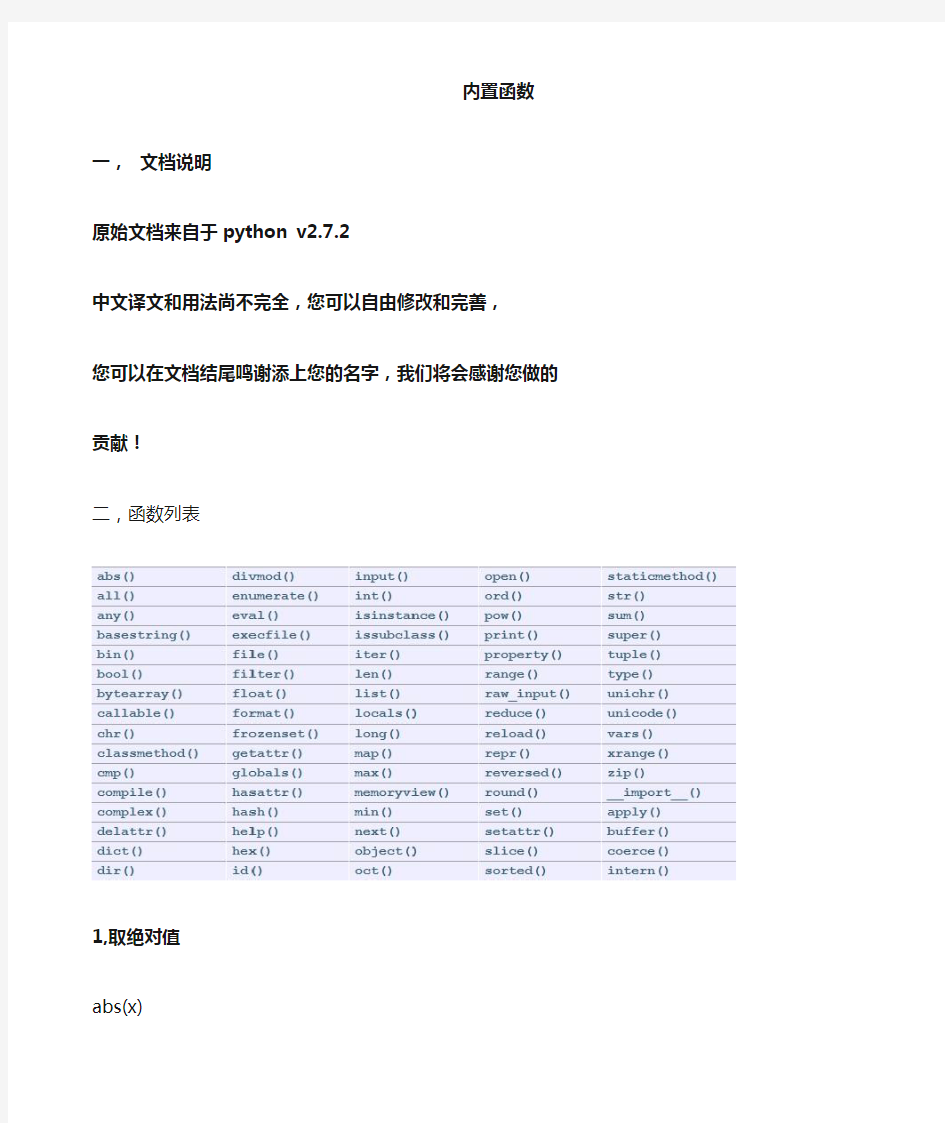python函数中文手册

- 1、下载文档前请自行甄别文档内容的完整性,平台不提供额外的编辑、内容补充、找答案等附加服务。
- 2、"仅部分预览"的文档,不可在线预览部分如存在完整性等问题,可反馈申请退款(可完整预览的文档不适用该条件!)。
- 3、如文档侵犯您的权益,请联系客服反馈,我们会尽快为您处理(人工客服工作时间:9:00-18:30)。
内置函数
一,文档说明
原始文档来自于python v2.7.2
中文译文和用法尚不完全,您可以自由修改和完善,
您可以在文档结尾鸣谢添上您的名字,我们将会感谢您做的
贡献!
二,函数列表
1,取绝对值
abs(x)
Return the absolute value of a number. The argument may be a plain or long integer or a floating point number. If the argument is a complex number, its magnitude is returned. 如果你不知道绝对值什么意思,那就要补一下小学数学了!
基本用法
2,
all(iterable)
Return True if all elements of the iterable are true (or if the iterable is empty). Equivalent to:
3.
any(iterable)
Return True if any element of the iterable is true. If the iterable is empty, return False. Equivalent to:
4.
basestring()
This abstract type is the superclass for str and unicode. It cannot be called or instantiated, but it can be used to test whether an object is an instance of str or unicode. isinstance(obj, basestring) is equivalent to isinstance(obj, (str, unicode)).
是字符串和字符编码的超类,是抽象类型。不能被调用或者实例化。可以用来判断实例是否为字符串或者字符编码。
方法:
5.二进制转换
bin(x)
Convert an integer number to a binary string. The result is a valid Python expression. If x is not a Python int object, it has to define an __index__() method that returns an integer.
转换成二进制表达
方法:
6.布尔类型
bool([x])
Convert a value to a Boolean, using the standard truth testing procedure. If x is false or omitted, this returns False; otherwise it returns True. bool is also a class, which is a subclass of int. Class bool cannot be subclassed further. Its only instances are False and True
布尔类型的转化
用法:
7. 二进制数组的转化
bytearray([source[, encoding[, errors]]])
Return a new array of bytes. The bytearray type is a mutable sequence of integers in the range 0 <= x < 256. It has most of the usual methods of mutable sequences, described in Mutable Sequence Types, as well as most methods that the str type has, see String Methods. The optional source parameter can be used to initialize the array in a few different ways: •If it is a string, you must also give the encoding (and optionally, errors) parameters; bytearray() then converts the string to bytes using str.encode().
•If it is an integer, the array will have that size and will be initialized with null bytes.
•If it is an object conforming to the buffer interface, a read-only buffer of the object will be used to initialize the bytes array.
•If it is an iterable, it must be an iterable of integers in the range 0 <= x < 256, which are used as the initial contents of the array.
Without an argument, an array of size 0 is created.
8.
callable(object)
Return True if the object argument appears callable, False if not. If this returns true, it is still possible that a call fails, but if it is false, calling object will never succeed. Note that classes are callable (calling a class returns a new instance); class instances are callable if they have a __call__() method.
9.数字转化成字符
chr(i)
Return a string of one character whose ASCII code is the integer i. For example, chr(97) returns the string 'a'. This is the inverse of ord(). The argument must be in the range [0..255], inclusive; ValueError will be raised if i is outside that range. See also unichr().
用法:
10.
classmethod(function)
Return a class method for function.
